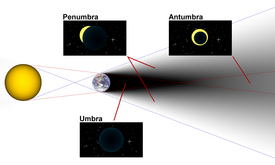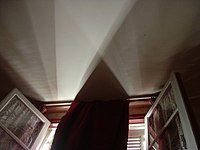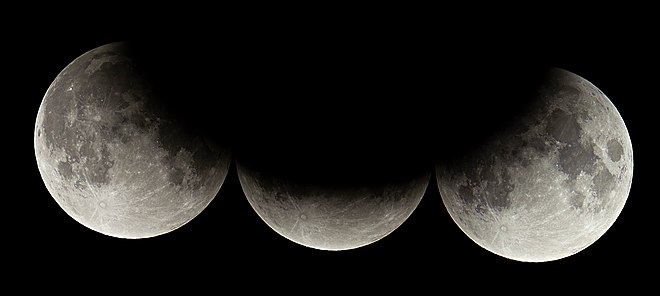Umbra, penumbra and antumbra


The umbra, penumbra and antumbra are three distinct parts of a shadow, created by any light source after impinging on an opaque object. Assuming no diffraction, for a collimated beam (such as a point source) of light, only the umbra is cast.
These names are most often used for the shadows cast by celestial bodies, though they are sometimes used to describe levels, such as in sunspots.
Umbra
[edit]
The umbra (Latin for "shadow") is the innermost and darkest part of a shadow, where the light source is completely blocked by the occluding body. An observer within the umbra experiences a total occultation. The umbra of a round body occluding a round light source forms a right circular cone. When viewed from the cone's apex, the two bodies appear the same size.
The distance from the Moon to the apex of its umbra is roughly equal to that between the Moon and Earth: 384,402 km (238,856 mi). Since Earth's diameter is 3.7 times the Moon's, its umbra extends correspondingly farther: roughly 1.4 million km (870,000 mi).[1]
Penumbra
[edit]The penumbra (from the Latin paene "almost, nearly" and umbra "shadow") is the region in which only a portion of the light source is obscured by the occluding body. An observer in the penumbra experiences a partial eclipse. An alternative definition is that the penumbra is the region where some or all of the light source is obscured (i.e., the umbra is a subset of the penumbra). For example, NASA's Navigation and Ancillary Information Facility defines that a body in the umbra is also within the penumbra.[2]


Antumbra
[edit]
The antumbra (from the Latin ante "before" and umbra "shadow") is the region from which the occluding body appears entirely within the disc of the light source. An observer in this region experiences an annular eclipse, in which a bright ring is visible around the eclipsing body. If the observer moves closer to the light source, the apparent size of the occluding body increases until it causes a full umbra.[3]
See also
[edit]References
[edit]- ^ Pogge, Richard. "Lecture 9: Eclipses of the Sun & Moon". Astronomy 161: An Introduction to Solar System Astronomy. Ohio State University. Retrieved July 16, 2015.
- ^ Event Finding Subsystem Preview Navigation and Ancillary Information Facility.
- ^ "Eclipses: What Is the Antumbra?". timeanddate.com. Retrieved 26 May 2019.
Text is available under the CC BY-SA 4.0 license; additional terms may apply.
Images, videos and audio are available under their respective licenses.
